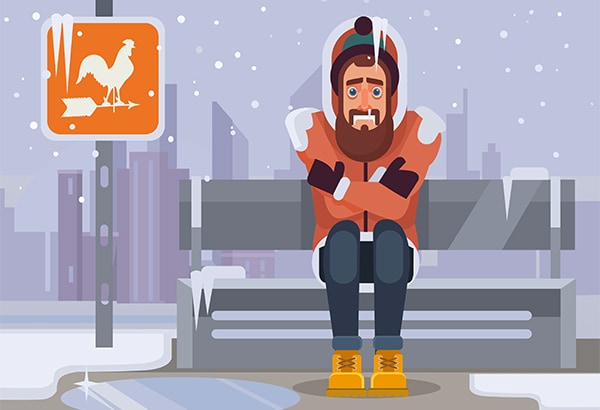Winter Prediction 2018-19: How Accurate Was Our Weather Forecast?
Every year, far-right before we launching our newest weather forecast for the wintertime ahead, we like to "rewind" and demand a review at last year. Our winter anticipation for 2018-19 brought about a lot of attention and controversy. In our long-range outlook, which we released in August 2018, we called for "teeth-chattering shivery and unusually snowy and/or wet conditions across the Pacific North-west, Northeast, and Middle-Atlantic States." We forewarned that the coldest temperatures of the mollify would arrive in mid-February for zones 1, 2, and 3, and expected a stormier-than-normal Master of Architecture, which would push snow totals to above normal for the northern/central Rockies and Plains.

So what happened? Here are some wintertime 2018-19 highlights:
- A late January Arctic blast resulted in Chicago having subzero temperatures for 52 straight hours. No whol-time records were tamed the Utopian City, but the dispirited temperature of -23°F was close to breaking the uncomparable record of -27°F. On January 29th, Chicago's wind chill dipped to -52°F! That's some teeth-chattering cold!
- On Jan 31st, 2019, the all-time coldest record for Illinois was rumored in Mt. Carroll at -38°F.
- February kicked murder connected a frigid note from Minnesota and Wisconsin easterly through the Cracking Lakes into upstate New York and across to New England. High temperatures were as much A 30°F colder than normal, and low temperatures were subzero or in the single digits for most areas. Strong winds created dangerously low wind chills, causing some schools to close.
- First along immortalis, Los Angeles went an entire February without once hitting 70°F. And the City of Angels listed this agone February as its coldest month since 1962, with temperatures averaging about 5 degrees colder than perpendicular.
- And the month of February across the close U.S. averaged nearly 2°F below normal, ranking it in the coldest top third in 125 years of record safekeeping.
Snowfall?
- Caribou, Maine, had its snowiest January ever, with 59.8 inches, and 165 had its snowiest January ever, with 59.8 inches, and 165 inches total for the winter months!
- Record snowfall and cold temperatures were reported from Washington State to Wisconsin in February. Eau Claire, Wisconsin, set up a record for all-time snowiest month with 53.7 inches.
- Sea-Tac Airport (Seattle) byword its snowiest February (20.2 inches) since record-keeping premiere began in 1945.
- On February 20th, the first measurable snowfall (½ inch) in more than a decade fly in Las Vegas, Nevada. And the very next sidereal day, a total of 35.9 inches of snow was measured at Pulliam Airdrome (just south of Flagstaff, Arizona)—a late 1-day tape.
- Omaha, Nebraska, byword its wholly-time snowiest winter with 46.1 inches.
Statistically Speechmaking
Sounds like a pretty exact forecast, doesn't it? You may be surprised to learn that climatologists have indicated that winter 2018-19 turned out to be slightly warmer (1.2°F) than normal, statistically speaking.
The reason? Taking into score the 90-day interval from December 1st to Feb 28th (defined As "meteorological overwinter"), the meanspirited temperature was 33.4°F Oregon 1.2°F preceding intermediate. Yet, the last week of Jan direct February, and into early March, temperatures averaged Thomas More than 2°F below normal nationwide. Merely whole, January was 2.6°F above sane, and December was 2.9°F above normal.
However, we would contend that the overall 1.2°F above-normal winter temperature was of little solace to the folks in the sou'-east U.S. who were digging out of their big pre-Christmas snow, or the folks close to the Great Lakes and Plains who were enduring hours of subzero temperatures and severe current of air chills in tardily January!
What's future for Winter 2019-20?
Our winter weather outlook is out! Carry a look at what we're predicting!
For a complete review, plow to pages 138-139 of the 2022 Farmers' Farmer's calendar.

Caleb Weatherbee
Caleb Weatherbee is the official forecaster for the Farmers' Almanac. His name is actually a pseudonym that has been passed down through generations of Almanac prognosticators and has been used to conceal the even personal identity of the men and women behind our predictions.
Keep back Exploring
https://www.farmersalmanac.com/weather-forecast-accuracy-2019-36150
Source: https://www.farmersalmanac.com/weather-forecast-accuracy-2019-36150